The look and feel of your bathroom depends on several design choices, but one element rules them all: the bathtub material you select. Attention-grabbing bathtub materials breathe life into the room and add your personal touch. What is the best bathtub material for your dream bathroom?
How To Choose the Best Bathtub Material
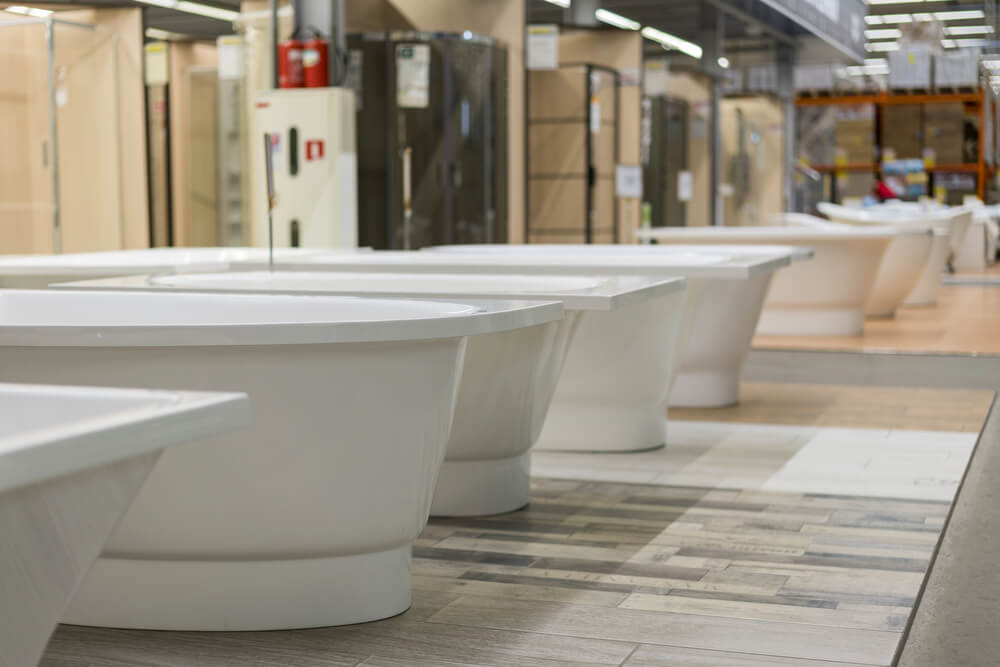
Figuring out what type of bathtub material is best for your space depends heavily on your personality. To create the ideal bathtub, you need to ask yourself a few questions.
Room Design: What Ambience Are You Looking for?
Some materials give off a modern vibe, and others channel the 1700s. Here are a few possibilities:
-
Design themes: Minimalist, contemporary, art deco, retro, Bohemian, industrial chic, and country comfort
-
Locations: The Mediterranean, Europe, India, Southeast Asia, South America, and The Caribbean
-
Ambience: Luxurious, calming, energizing, bright, and glamorous
Freestanding copper tubs look elegant and artistic, like period pieces for French royalty. On the other hand, brilliant porcelain enamel surfaces make rooms feel relaxing, spacious, and positive.
Bathtub Style: Are You Building a Drop-In or Freestanding Tub?
The size and shape of your tub influence what is the best material for your bathtub needs. For example, if you have a drop-in bathtub with a custom hardwood base, you won’t be able to see the eye-catching exterior of a copper or brass tub.
Copper is a better choice for freestanding or claw-foot bathtubs. Complex bathtub designs, such as walk-in tubs or hydromassage models, are usually only available with acrylic or composite materials.
Material Weight: How Much Weight Can Your Floors Hold?
The weight of a bathtub depends on what type of material you choose, the material thickness, and the size of the tub. Acrylic and composite products are generally lightweight. On the other end of the scale, cast iron tubs can weigh anywhere from 400 to 500 pounds.
Not all homes are equipped to handle that type of weight. How much is too much depends on the size of your floor joists. Many homes can support loads up to 30 to 40 pounds per square foot. To hold a 400-pound clawfoot tub, plus water (8.35 pounds per gallon) and a person, the floor needs to support double that psf rating or more.
Of course, the location of your bathroom also plays a role. If you’re remodeling a main-floor en-suite bathroom, your builders can likely accommodate the extra weight without issues.
Color Palette: Is Your Bathroom Warm, Cool, or Colorful?
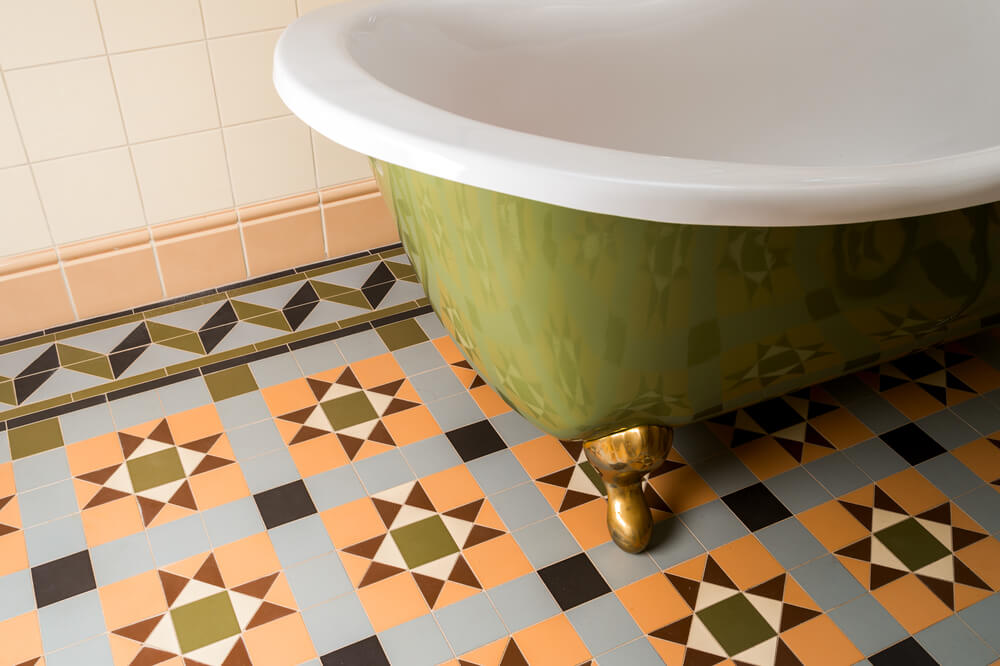
White enameled finishes are easy to match with any color palette. They lack a certain wow factor, though.
Copper is a warm metal that makes bathrooms feel cozy and safe. Brass can take on a golden polish or dark and mysterious tones depending on your preferences.
For intense colors like blues, purples, and greens, acrylic or polymer resins are the best materials for your bathtub. Stone composites also have a range of color options.
Project Budget: How Much Do You Want To Spend?
Bathtub materials range in price from a few hundred to many thousands of dollars. Simpler materials like acrylic have a much lower cost, which explains why they’re also more common.
Rarer or harder-to-forge materials have a higher cost, such as stainless steel or solid marble. You can also expect to pay more for handcrafted or custom luxury finishes, like hammered copper.
Did you know that 60% of Americans, both men and women, take bubble baths? Most people (65%) spend 10 to 30 minutes in the tub, but a large percentage soak for an hour or more.
It’s worth investing in the best bathtub material for your personal bath space, one that makes you smile every time. For guest bathrooms, you probably want to balance cost with design flair.
Temperature: How Hot Is Just Right?
One factor that many homeowners overlook when comparing bathtub materials is heat retention capabilities. Metal tubs can keep bathwater piping hot for a long time. If that sounds perfect for your nightly soaking ritual, choose a copper or brass tub.
Pros and Cons of Popular Bathtub Materials
Now that you have a clearer picture of what you’re looking for in the best bathtub material, it’s time to compare your options one at a time. To make things simpler, we organized the materials in alphabetical order.
1. Acrylic
Acrylic is a high-quality, durable polymer. It’s versatile, supporting practically limitless designs, from walk-in tubs for comfort to artistic creations.
Acrylic tubs are usually available from the factory in basic shades of white. Some manufacturers produce black, dark blue, or cream acrylics.
Does your room theme call for something bolder? Specialty shops can add brighter colors to a white acrylic tub with marine paint.
Pros
-
Widely available and affordable
-
Lightweight
-
Countless bathtub types and designs
-
Many color options
Cons
-
Vulnerable to scratches
-
Vulnerable to damage or discoloration from cleaning chemicals
-
Needs extra support to avoid warping
-
Loses heat quickly
2. Copper
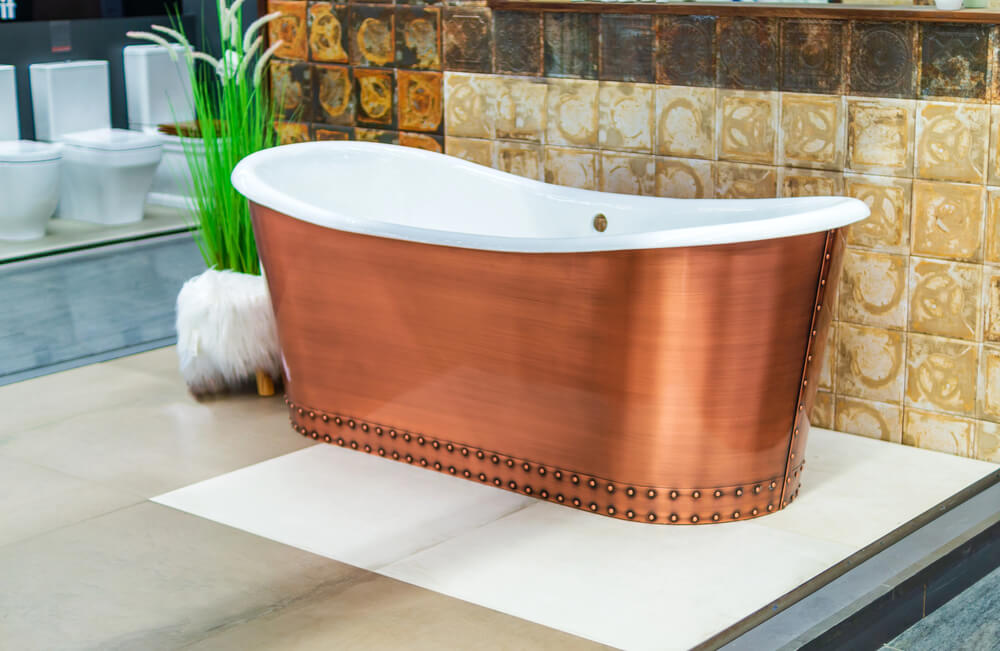
If there’s one material that seems like it was destined for high-end bathtubs, it’s copper. A copper bathtub provides it all: sophistication, color, warmth, and comfort.
Traditionally, copper hues range from light orange to reddish tones. Over time, it develops a rich patina that is unique to each piece. At World CopperSmith, we can create lighter and darker colors with specialized aging and burnishing techniques.
Copper is one of the best bathtub materials for thermal retention, distributing the heat from a hot bath to your muscles and keeping the water hotter longer. Copper is also naturally resistant to microbes and mildew, keeping the tub clean and refreshing.
Pros
-
Vibrant and attention-grabbing
-
Elegant and beautiful
-
Versatile, fitting nearly any design style
-
Hygienic and easy to care for
-
Perfect for soaking
Cons
Not many manufacturers specialize in copper, making it a rare and exclusive material, often used in custom-made products. Copper bathtubs are heavy enough to often require structural support.
3. Enameled Cast Iron
When it comes to traditional clawfoot or rolled bathtubs, few materials are more iconic than cast iron. Cast iron tubs add a touch of classic Americana or Victorian flair.
They’re made by pouring molten metal into a sand mold. This allows for the detailed flourishes that make these tubs easy to recognize.
Most cast-iron bathtubs feature a white enamel coating on the inside, providing a long-lasting and hard layer that resists staining and scratches. For the exterior, you can choose between a fully enameled white tub, the dark black color of traditional cast iron, or a rainbow of painted surfaces.
Pros
-
Lasts decades
-
Resists chipping, scratches, and staining
-
Allows for resurfacing and repairs
-
Comes in a huge variety of finish colors
Cons
-
Extremely heavy
-
Difficult to install or replace
-
Expensive
-
Only available in freestanding designs
-
Only white enamel interior
4. Porcelain Enameled Steel
One of the best types of bathtub material for remodeling projects, enameled steel works well for nearly any bathtub shape, including drop-in and built-in baths, corner baths, and recessed designs. Steel is a rigid and strong material that can last for ages if properly cared for.
Pros
-
Cost-effective
-
Strong and durable
-
Scratch- and stain-resistant
-
Easy to clean
-
Available in most bath styles
Cons
-
Relatively common
-
Lacks wow factor
-
Only available in white
-
Vulnerable to chipping
-
Doesn’t retain heat as well as other metals
5. Stone Composite
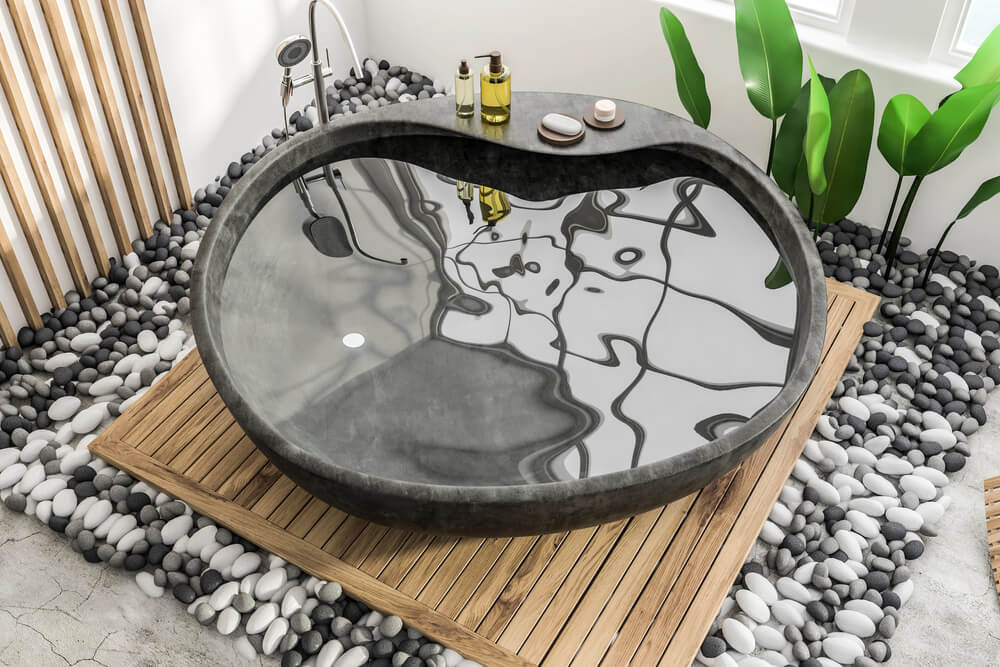
State-of-the-art bathtub materials can bring the look of stone into your bathroom, without the excessive costs of quarried stone. Composites combine polymers, resins, and stone powders — usually granite, stone quartz, or cultured onyx.
The end result resembles solid-surface tables and countertops, giving the bathroom a contemporary yet elegant feel. By adding pigments to the material, manufacturers can create nearly any color.
Pros
-
Lightweight
-
Highly customizable
-
Better at retaining heat than acrylic or enameled steel
-
Excellent strength-to-weight ratio, allowing for smaller footprint in cozy bathrooms
Cons
-
Protective gel coating eventually wears down
-
Can be vulnerable to cracks
-
Cracks can’t be repaired, must replace
6. Tin
Tin bathtubs have a niche following that merits attention. The moment you see a tin bath, it brings to mind images of the Old West. This material is a good fit for rustic or country-style comfort bathrooms.
When shopping for a tin bathtub, keep in mind that the quality can vary considerably. The metal’s gauge determines how strong it is.
Pros
-
One of the lightest metals for bathtubs
-
Readily available, with many different standard designs
-
Recyclable and potentially eco-friendly
Cons
-
Galvanized finishes can look cheap
-
Material can be noisy, especially thinner gauges
-
Bare tin is extremely vulnerable to rust
Some tin bathtubs use an enamel interior for easier cleaning and maintenance.
The Best Bathtub Materials for Luxury Bathrooms
Truly unique materials don’t come cheap, but that’s kind of the point. You deserve to pamper yourself with luxury sometimes, and a picturesque bath is the perfect place for it.
7. Brass
Brass is a malleable alloy of copper and zinc with outstanding strength and durability. The color of brass bathtubs depends on their finish.
Burnished or polished brass offers irresistible gold tones that treat you like royalty. This option elevates any design style, from 1920s vintage and art deco to French chic and modern glam.
If you allow brass to develop a patina, brownish or greenish tints can start to appear. Darkened brass turns deep brown, almost black.
Like copper, brass has natural antibacterial properties and doesn’t rust. This makes cleaning and care a breeze.
Pros
-
The epitome of luxury and elegance
-
Rare material with an exclusive feel
-
A head-turning centerpiece for en-suite bathrooms
-
Outstanding heat retention and comfort
-
Wide customizability
Cons
-
Smaller range of bathtub designs
-
Heavier than copper
-
More expensive than copper
-
Requires periodic polishing to stay shiny
Copper and brass are both excellent materials for a stylish bathroom. At the end of the day, your choice mainly comes down to the metallic tones you’re looking for.
8. Solid Stone
Solid marble, granite, river stone, and other natural hewn materials offer an opulence that is difficult to find anywhere else. They convey images of ancient Greece, Rome, or China, providing natural beauty and strength.
Unfortunately, that luxury comes with a heavy cost, and not just in terms of money. Sourcing, shaping, transporting, and installing large stone baths is a monumental task. Like granite or marble countertops, solid stone tubs also require extensive maintenance to prevent stains and keep surfaces shiny and clean.
Pros
-
Lustrous and luxurious
-
Artistic look
-
Ancient feel
Cons
-
Excessive weight
-
Difficulty finding and installing
-
Extreme cost
-
High maintenance and care requirements
9. Stainless Steel
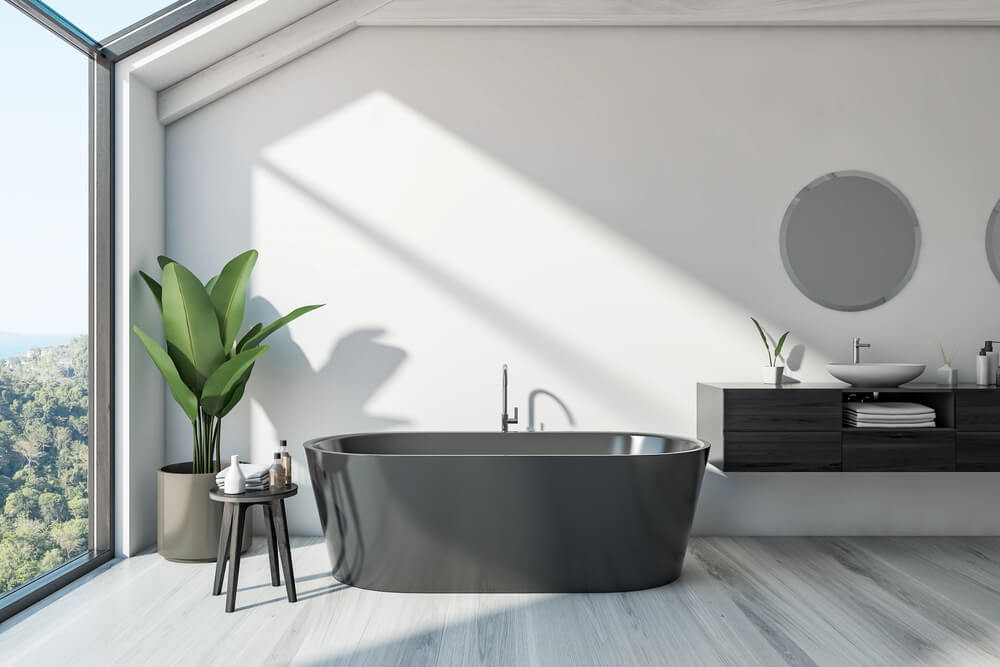
Stainless steel is a common material for home remodeling and decor, but not when it comes to bathtubs. This shiny metal brightens up any bathroom, almost giving off the look of platinum.
With a few simple care tips, high-quality stainless steel tubs won’t tarnish or corrode, staying gorgeous for ages. It’s essentially a superior alternative to tin, with all the glam and none of the rust.
Pros
-
Bright and energizing
-
Matte and glossy finishes
-
Naturally rust-resistant
-
Lighter than copper and brass
-
Ideal for any contemporary style
Cons
-
Requires drying after every bath
-
Harder to find
-
Good heat resistance, but not as much as copper
10. Wood
Wood bathtubs bring a breath of fresh air into the bathroom. They provide an exotic ambiance, reminiscent of resting in an Asian bathhouse or a tropical spa. Wood tubs are usually round, but some are oval or rectangular.
Why aren’t wood baths more popular? Put simply, they’re a nightmare to maintain, and they don’t last as long as other options. Too much or too little moisture can ruin a wood bathtub, leading to premature cracking or warping.
Pros
-
Relaxing ambiance
-
Warm, natural material
-
Supreme comfort
Cons
-
Not always eco-friendly
-
Extremely complex to maintain
-
Porous material is vulnerable to drying out or warping
Wood is traditional for a Japanese soaking tub, but these days, many homeowners choose a circular or square copper tub for relaxation instead.
Discover the Best Bathtub Material for Your Design Style
Taking your time to choose the best bathtub material is a smart investment. Not only does it add to the value of your home, but it also makes your bathroom the ideal haven to relax and recharge. Browse World CopperSmith’s complete range of luxury bathtub materials for inspiration, or start customizing right away.